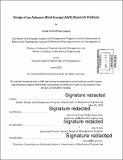Design of an airborne wind energy (AWE) research platform
Author(s)
Perez Damas, Carlos Emilio
DownloadFull printable version (12.44Mb)
Alternative title
Design of an AWE research platform
Other Contributors
Massachusetts Institute of Technology. Department of Mechanical Engineering.
Advisor
Warren Seering.
Terms of use
Metadata
Show full item recordAbstract
Airborne wind energy (AWE) technologies have the potential to become a dominant source of clean electricity generation and help humanity reach many of the key sustainable development goals (SDGs) established by the United Nations as part of the 2030 Agenda for Sustainable Development. AWE systems eliminate the need for a tower, large blades and substantial foundations used in modern wind turbines and replace it with a wing (i.e. kite or glider aircraft) tethered to the ground. This technology can reach higher-altitude winds which is an untapped source of clean and highly abundant energy with the potential to power civilization 100 times over. As part of this work, an AWE research platform has been designed and developed based on a concept that emphasizes low-complexity, safety and low-cost. This research platform can be used to evaluate different sensor frameworks, airfoil/tether designs, control systems and optimal operational strategies for AWE systems operating under lift mode. A first-order techno-economic analysis was also performed to assess the cost and technical feasibility of developing a small-scale AWE system for distributed generation applications. In addition to estimating the approximate cost of the system, the analysis also determines the potential power generated by a specific AWE system design operating at a maximum elevation of 152 meters, to comply with existing regulation. The results of the techno-economic analysis suggest that small-scale AWE systems have the potential to produce electricity at a much lower cost than small-wind turbines of the same rated capacity.
Description
Thesis: S.M. in Engineering and Management, Massachusetts Institute of Technology, System Design and Management Program, 2018. Thesis: S.M., Massachusetts Institute of Technology, Department of Mechanical Engineering, 2018. Cataloged from PDF version of thesis. Includes bibliographical references (pages 121-126).
Date issued
2018Department
Massachusetts Institute of Technology. Engineering and Management Program; Massachusetts Institute of Technology. Integrated Design and Management Program.; Massachusetts Institute of Technology. Department of Mechanical EngineeringPublisher
Massachusetts Institute of Technology
Keywords
Engineering and Management Program., Integrated Design and Management Program., Mechanical Engineering.